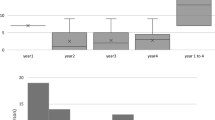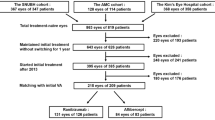Abstract
Purpose
To determine factors predictive of visual outcomes in eyes treated with intravitreal aflibercept injections (IAIs) for typical neovascular age-related macular degeneration (AMD) or polypoidal choroidal vasculopathy (PCV).
Study design
Retrospective, multicenter, institutional, consecutive, interventional case series.
Methods
One hundred nine eyes (107 patients) with treatment-naïve neovascular AMD at 3 university hospitals were studied. After a loading phase of 3 monthly 2.0-mg IAIs, injections were administered every 2 months. The baseline clinical characteristics were investigated in relation to the 12-month visual outcomes. Changes in the mean best-corrected visual acuity (BCVA) were measured at 12 months after initiation of aflibercept therapy.
Results
Forty-five eyes (41.3%) had typical neovascular AMD, and 64 eyes (58.7%) had PCV. The changes in the mean BCVA at 12 months compared with baseline did not differ significantly (P = .737) between the 2 groups. Stepwise analysis showed that larger gains in the BCVA at 12 months were associated with poor BCVA (P < .001), no pigment epithelial detachment (P = .004), and subretinal fluid (P = .039) at baseline in eyes with typical neovascular AMD; larger gains in the BCVA were associated with poorer BCVA (P < .001), presence of choroidal vascular hyperpermeability (CVH) (P = .013), and subretinal fluid (P = .044) at baseline in eyes with PCV.
Conclusions
Although poorer BCVA and the presence of subretinal fluid predicted larger gains in BCVA in both subtypes treated with aflibercept, eyes with typical neovascular AMD had greater improvement if no pigment epithelial detachment was present, while eyes with PCV had greater improvement if CVH was present.



Similar content being viewed by others
References
Smith W, Assink J, Klein R, Mitchell P, Klaver CC, Klein BE, et al. Risk factors for age-related macular degeneration: pooled findings from three continents. Ophthalmology. 2001;108:697–704.
Maruko I, Iida T, Saito M, Nagayama D, Saito K. Clinical characteristics of exudative age-related macular degeneration in Japanese patients. Am J Ophthalmol. 2007;144:15–22.
Yannuzzi LA, Sorenson J, Spaide RF, Lipson B. Idiopathic polypoidal choroidal vasculopathy (IPCV). Retina. 1990;10:1–8.
Yuzawa M, Mori R, Haruyama M. A study of laser photocoagulation for polypoidal choroidal vasculopathy. Jpn J Ophthalmol. 2003;47:379–84.
Heier JS, Brown DM, Chong V, Korobelnik JF, Kaiser PK, Nguyen QD, et al. Intravitreal aflibercept (VEGF trap-eye) in wet age-related macular degeneration. Ophthalmology. 2011;119:2537–48.
Yamamoto A, Okada AA, Koizumi H, Maruko I, Sekiryu T, Iida T, et al. One-year results of intravitreal aflibercept for polypoidal choroidal vasculopathy. Ophthalmology. 2015;122:1866–72.
Kaiser PK, Brown DM, Zhang K, Hudson HL, Holz FG, Shapiro H, et al. Ranibizumab for predominantly classic neovascular age-related macular degeneration: subgroup analysis of first-year ANCHOR results. Am J Ophthalmol. 2007;144:850–7.
Yamashiro K, Tomita K, Tsujikawa A, Nakata I, Akagi-Kurashige Y, Miyake M, et al. Factors associated with the response of age-related macular degeneration to intravitreal ranibizumab treatment. Am J Ophthalmol. 2012;154:125–36.
Simader C, Ritter M, Bolz M, Deak GG, Mayr-Sponer U, Golbaz I, et al. Morphologic parameters relevant for visual outcome during anti-angiogenic therapy of neovascular age-related macular degeneration. Ophthalmology. 2014;121:1237–45.
Schmidt-Erfurth U, Waldstein SM, Deak GG, Kundi M, Simader C. Pigment epithelial detachment followed by retinal cystoid degeneration leads to vision loss in treatment of neovascular age-related macular degeneration. Ophthalmology. 2015;122:822–32.
Broadhead GK, Hong T, Zhu M, Li H, Schlub TE, Wijeyakumar W, et al. Response of pigment epithelial detachments to intravitreal aflibercept among patients with treatment-resistant neovascular age-related macular degeneration. Retina. 2015;35:975–81.
Koizumi H, Yamamoto A, Maruko I, Sekiryu T, Okada AA, Iida T, et al. Subfoveal choroidal thickness during aflibercept therapy for neovascular age-related macular degeneration: twelve-month results. Ophthalmology. 2016;123:617–24.
Jaffe GJ, Martin DF, Toth CA, Daniel E, Maguire MG, Ying GS, et al. Macular morphology and visual acuity in the comparison of age-related macular degeneration treatments trials. Ophthalmology. 2013;120:1860–70.
Ikuno Y, Yasuno Y, Miura M, Sekiryu T, Nishida K, Iida T, et al. Reproducibility of retinal and choroidal thickness measurements in enhanced depth imaging and high-penetration optical coherence tomography. Invest Ophthalmol Vis Sci. 2011;52:5536–40.
Cho M, Barbazetto IA, Freund KB. Refractory neovascular age-related macular degeneration secondary to polypoidal choroidal vasculopathy. Am J Ophthalmol. 2009;148:70–8.
Koizumi H, Yamagishi T, Yamazaki T, Kinoshita S. Relationship between clinical characteristics of polypoidal choroidal vasculopathy and choroidal vascular hyperpermeability. Am J Ophthalmol. 2013;155:305–13.
Saito M, Iida T, Kano M, Itagaki K. Two-year results of intravitreal ranibizumab for polypoidal choroidal vasculopathy with recurrent or residual exudation. Eye (Lond). 2013;27:931–9.
Hikichi T, Kitamei H, Shioya S. Prognostic factors of 2-year outcomes of ranibizumab therapy for polypoidal choroidal vasculopathy. Br J Ophthalmol. 2015;99:817–22.
Kang HM, Koh HJ. Long-term visual outcome and prognostic factors after intravitreal ranibizumab injections for polypoidal choroidal vasculopathy. Am J Ophthalmol. 2013;156:652–60.
Koizumi H, Yamagishi T, Yamazaki T, Kinoshita S. Predictive factors of resolved retinal fluid after intravitreal ranibizumab for polypoidal choroidal vasculopathy. Br J Ophthalmol. 2011;95:1555–9.
Hikichi T, Higuchi M, Matsushita T, Kosaka S, Matsushita R, Takami K, et al. Factors predictive of outcomes 1 year after 3 monthly ranibizumab injections and as-needed reinjections for polypoidal choroidal vasculopathy in Japanese patients. Retina. 2013;33:1949–58.
Kang HM, Kwon HJ, Yi JH, Lee CS, Lee SC. Subfoveal choroidal thickness as a potential predictor of visual outcome and treatment response after intravitreal ranibizumab injections for typical exudative age-related macular degeneration. Am J Ophthalmol. 2014;157:1013–21.
Cho HJ, Kim HS, Jang YS, Han JI, Lew YJ, Lee TG, et al. Effects of choroidal vascular hyperpermeability on anti-vascular endothelial growth factor treatment for polypoidal choroidal vasculopathy. Am J Ophthalmol. 2013;156:1192–200.
Julien S, Biesemeier A, Taubitz T, Schraermeyer U. Different effects of intravitreally injected ranibizumab and aflibercept on retinal and choroidal tissues of monkey eyes. Br J Ophthalmol. 2014;98:813–25.
Stewart MW, Rosenfeld PJ. Predicted biological activity of intravitreal VEGF Trap. Br J Ophthalmol. 2008;92:667–8.
Takahashi S. Vascular endothelial growth factor (VEGF), VEGF receptors and their inhibitors for antiangiogenic tumor therapy. Biol Pharm Bull. 2011;34:1785–8.
Author information
Authors and Affiliations
Corresponding author
Ethics declarations
Conflicts of interest
M. Ogasawara, None; Hideki Koizumi, Grant (Novartis Pharma), Moderator fees (Alcon, Bausch & Lomb, Bayer, Canon, HOYA, Kowa, NIDEK, Novartis Pharma, Santen Pharmaceutical, Senju Pharmaceutical, Topcon, Wakamoto Pharmaceutical); A. Yamamoto, Lecture fees (Bayer, Novartis Pharma, Pfizer, Santen Pharmaceutical); K. Itagaki, None; M. Saito, Grant (Bayer, Novartis Pharma, Santen Pharmaceutical), Moderator fees (Alcon, AMO, Bayer, HOYA, Novartis Pharma, Santen Pharmaceutical, Senju Pharmaceutical); I. Maruko, Moderator fees (Alcon, Bayer, NIDEK, Novartis Pharma, Santen Pharmaceutical, Topcon); A. A. Okada, Grant (Bayer, Mitsubishi Tanabe Pharma), Advisory board fee (Bayer), Consultant fee (XOMA), Lecture fees (Bayer, Novartis Pharma, Santen Pharmaceutical), Research funds (Bayer, Mitsubishi Tanabe Pharma); T. Iida, Grant (Bayer, Nidek, Novartis Pharma, Santen Pharmaceutical), Lecture fees (Bayer, Novartis Pharma, Santen Pharmaceutical); T. Sekiryu, None.
Additional information
Corresponding author: Tetsuju Sekiryu
About this article
Cite this article
Ogasawara, M., Koizumi, H., Yamamoto, A. et al. Prognostic factors after aflibercept therapy for typical age-related macular degeneration and polypoidal choroidal vasculopathy. Jpn J Ophthalmol 62, 584–591 (2018). https://doi.org/10.1007/s10384-018-0605-6
Received:
Accepted:
Published:
Issue Date:
DOI: https://doi.org/10.1007/s10384-018-0605-6




